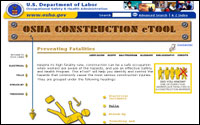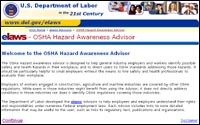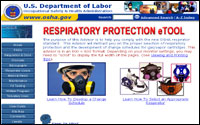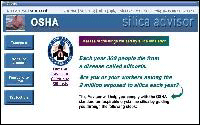 |
Safety and Health Topics |
  |
| Concrete and
Concrete Products - Manufacturing and Construction |
|
|
|
 |
In
Focus |
 |
|
|
Concrete is one of the most
widely used construction materials in the world. Safety issues
exist in all phases of concrete production, including the manufacture
of portland cement and pre-cast concrete products, as well as
during the use of concrete in construction.
This page is a product of OSHA's Alliance Program and Strategic Partnership with
the National Ready-Mix Concrete Association and was created
to help improve safety and health for the manufacture of concrete
and concrete products and for construction work with concrete.
The following questions link to resources that provide safety and health
information relevant to concrete and concrete products in the workplace.
|

|
What OSHA standards apply?
Manufacturing |
Construction |
 |
What are the industry segments and ways to control the principal hazards?
Block and Brick Manufacturing | Pipe Manufacturing | Ready-Mixed | Construction |
 |
How do I develop a safety and health program and find example programs?
Example Programs | General Resources |
 |
What additional information is available?
Training | Other Resources |
 |
In Focus |
 |
 |
Portland Cement
- OSHA implemented new Portland Cement Inspection Procedures at construction
sites as part of its settlement of a legal challenge to the new Hexavalent
Chromium Standard by the Building and Construction Trades Department, AFL-CIO,
Laborers' International Union of North America, and International Brotherhood
of Teamsters. The settlement agreement and the inspection procedures are
linked in an
OSHA Trade News Release, (2007, April 19).
-
Preventing Skin Problems from Working with Portland Cement. (2008). Employees may suffer
dermal hazards in working with wet cement such as cement burns (due to its caustic nature) and
inflammation of the skin (either due to irritant or allergic contact dermatitis). This guidance
addresses ways to prevent or minimize skin problems through the proper selection and use of
gloves, boots and other personal protective equipment such as kneepads; proper skin care and work
practices such as use of pH neutral or slightly acidic soaps; and ways of making cement products
less hazardous.
Industry Profile
Publications
Alliances
Strategic Partnerships
News Releases
-
OSHA Program in Missouri Targets Concrete Industry. OSHA Regional News Release, (2006, March 13). OSHA is implementing a statewide
program in Missouri to identify, evaluate, and control the hazards associated with exposure to the manufacturing, production, mixing
and delivery of concrete in the workplace.
eTools/Expert Advisors
-
 Construction. OSHA. A
Spanish version is also available. Construction can be a safe occupation
when workers are aware of the hazards and an effective Safety and Health
Program is used. This eTool contains information that helps workers identify
and control the hazards that cause the most serious construction-related
injuries. Construction. OSHA. A
Spanish version is also available. Construction can be a safe occupation
when workers are aware of the hazards and an effective Safety and Health
Program is used. This eTool contains information that helps workers identify
and control the hazards that cause the most serious construction-related
injuries.
-
 Hazard
Awareness. OSHA. Designed to help general industry employers and
workers identify possible safety and health hazards in their workplace, and to
direct users to OSHA standards addressing those hazards. Hazard
Awareness. OSHA. Designed to help general industry employers and
workers identify possible safety and health hazards in their workplace, and to
direct users to OSHA standards addressing those hazards.
 Respiratory Protection. OSHA. Helps workers comply with the updated OSHA
respirator standard. This eTool will instruct you on the proper selection of
respiratory protection and the development of change schedules for gas/vapor
cartridges. Respiratory Protection. OSHA. Helps workers comply with the updated OSHA
respirator standard. This eTool will instruct you on the proper selection of
respiratory protection and the development of change schedules for gas/vapor
cartridges.
-
 Silica. OSHA. A
downloadable version is also available. Includes current information that
will assist
businesses and workers in identifying potential silica hazards in their
workplaces by choosing appropriate sampling and analytical techniques,
comparing monitoring results with the silica exposure limits, and selecting
appropriate short and long-term control options. Includes an
Advisor Genius which performs calculations for a Silica. OSHA. A
downloadable version is also available. Includes current information that
will assist
businesses and workers in identifying potential silica hazards in their
workplaces by choosing appropriate sampling and analytical techniques,
comparing monitoring results with the silica exposure limits, and selecting
appropriate short and long-term control options. Includes an
Advisor Genius which performs calculations for a
respirable dust sample.
|
|
|
|
|
|
|

